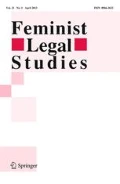Abstract
This interdisciplinary essay looks at the use of popular history for the critical understanding of the reconstruction of crime and patriarchal hierarchy. By way of reviewing the recent movie The Limehouse Golem, it illustrates the significance of theoretically engaging with a period crime fiction movie. It is argued that this assessment is less relevant in terms of producing historical understanding. Rather historical fiction reveals instead our own contemporary cultural fixations.
Similar content being viewed by others
Notes
The idea of ‘public history’ developed during the 1990s particularly in Australia, North America and the US. The practice was later introduced in the UK and Europe with the postmodern approach to history (Sayer 2015, 187).
The online project ‘Exploring the history of prisoner health’, lead by Catherine Cox and Hilary Marland is also engaged with art exhibitions and theatre production (https://histprisonhealth.com/arts-projects/ accessed 13 March 2018).
The National Justice Museum in Nottingham is currently hosting the Women in Prison Exhibition- ‘examining the treatment and experiences of female prisoners from the nineteenth-century to the present day’ (http://www.nationaljusticemuseum.org.uk/event/women-prison-exhibition/ accessed 13 March 2018)
Wayward Woman is a blog which examines the lives of Victorian England’s female offenders and it reflects the research carried out by Lucy Williams (https://waywardwomen.wordpress.com/about/ accessed 13 March 2018).
Capital Punishment Amendment Act 1868 (31 & 32 Vict. c.24).
See a digital history on Jack the Ripper and the Moors Murderers (Ian Brady and Myra Hindley): Criminal Mind WIKI: Criminal Minds Encyclopaedia http://criminalminds.wikia.com/wiki/Real_Criminals/Serial_Killers (accessed 13 Feb 2018).
See also National Portrait Gallery, National Memory Local Stories, Messages and Meanings: Words of War Vesta Tilley (1864–1952), https://www.npg.org.uk/whatson/national-memory-local-stories/resources/learning-resource-themes/messages-and-meanings-words-of-war/messages-and-meanings-words-of-warvesta-tilley-1864-1952/ (accessed 14 Feb 2018); Victorian and Albert Museum, Music Hall Character Acts, http://www.vam.ac.uk/content/articles/m/music-hall-character-acts/ (accessed 14 Feb 2018).
Although performers were suppressing their femininity by enhancing male imagery through dress and body language, in fact they created a rather androgynous character (Aston 1988, 248, 252).
See The murdermap.co.uk—a digital history addressing the Ratcliff Highway murders http://www.murdermap.co.uk/pages/blog_01/blog_item.asp?Blog_01ID=256 (accessed 14 Feb 2018).
References
Aristodemou, Maria. 2017. The Introduction Didn’t Do It. In Crime Fiction and the Law, ed. Maria Aristodemou, Fiona Macmillan, and Patricia Tuitt, 1–14. London: Birkbeck Law Press.
Aston, Elaine. 1988. Male Impersonation in the Music Hall: The Case of Vesta Tilley. New Theatre Quarterly 4: 247–257.
Bell, Erin, and Gray Ann. 2007. History on Television. Cultural Studies 10: 113–133.
Betnstein, Richard. 1989. Can Movies Teach History? The New York Times, 26 November.
Bulamur, Naz. 2016. Victorian Murderesses; the Politics of Female Violence. Cambridge: Cambridge Scholars Publishing.
Capital Punishment Amendment Act 1868 (31 & 32 Vict. c.24).
Carnes, Mark C. 1995. Past Imperfect: History According to Movies. NY: Henry Holt and Co.
hook, bel. 2012. Reel to Read: Race, Class and Sex at the Movies. London & NY: Routledge.
Kerstein, Benjamine. 2018. Interpretation of the Golem: Universal and particular. My Jewish Learning https://www.myjewishlearning.com/article/interpretations-of-the-golem/ Accessed 19 Feb 2018.
Michaelson, Jay. 2018. Golem, Making Men of Clay: Can imitating God extend to the creative realm?. My Jewish Learning https://www.myjewishlearning.com/article/golem/ Accessed 19 Feb 2018.
Naffine, Ngaire. 2007. Feminism and Criminology. Cambridge & Malden: Polity Press.
O’Neil, Brian. 2004. Reel History. In Defence of Hollywood (Review). The Public Historian 26: 94–96.
Pingree, Geoffrey B. 1999. Visual Evidence Reconsider: Reflection on Film and History (Review Essay). The Public Historian 21: 99–107.
Rafter, Nicole. 2000. Shots in the Mirrors. Oxford: Oxford University Press.
Rafter, Nicole Hahn, and Brown Michelle. 2011. Criminology Goes to the Movies: Crime Theory and Popular Culture. NY & London: NY University Press.
Robert, Morrison (ed.). 2009. On Murder by Thomas De Quincey. Oxford: Oxford University Press.
Sayer, Fayne. 2015. Public History: A Practical Guide. London: Bloomsbury.
Smart, Carol. 1976. Women, Crime and Criminology: A Feminist Critique. London: Routledge and Kegan Paul.
Smart, Carol. 1992. Regulating Womanhood. London and NY: Routledge.
Smith, Patrick. 2017. The Limehouse Golem Review: A Glorious Feminist Twist on Jack the Ripper. The Telegraph, 31 August.
Spongberg, M. 2002. Writing Women History since the Renaissance. London: Palgrave Macmillan.
Tosh, John. 2015. The Pursuit of History. London: Routledge.
Tosh, John. 2005. Manliness and Masculinities in Nineteenth-Century Britain. Harlow: Pearson.
Author information
Authors and Affiliations
Corresponding author
Rights and permissions
About this article
Cite this article
Menis, S. Public History and the Study of Law: Reviewing The Limehouse Golem (2017). Fem Leg Stud 26, 223–228 (2018). https://doi.org/10.1007/s10691-018-9372-5
Published:
Issue Date:
DOI: https://doi.org/10.1007/s10691-018-9372-5




